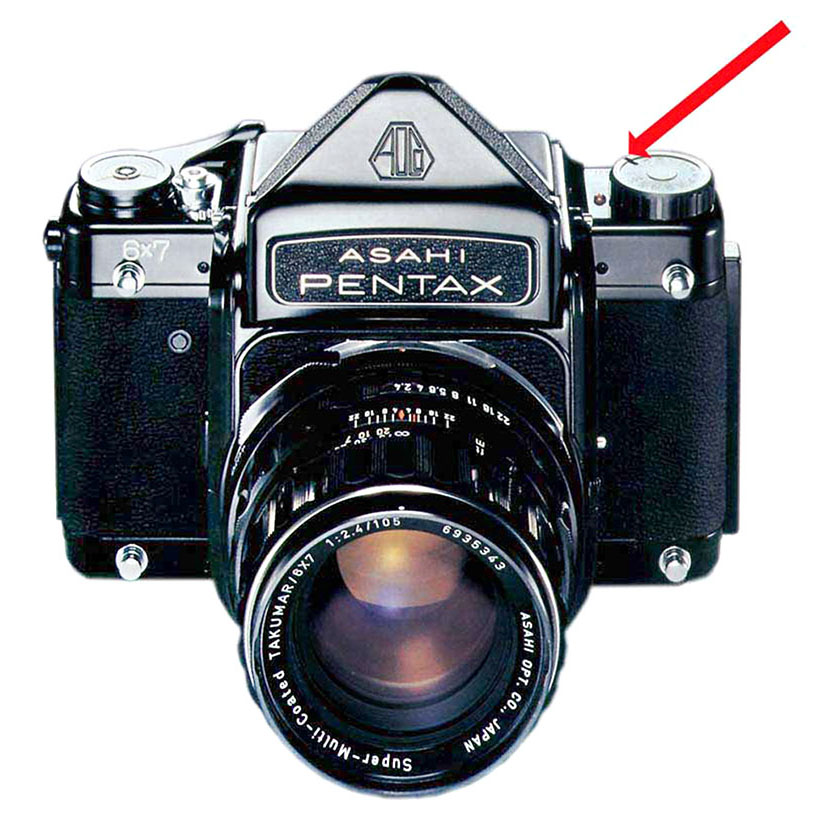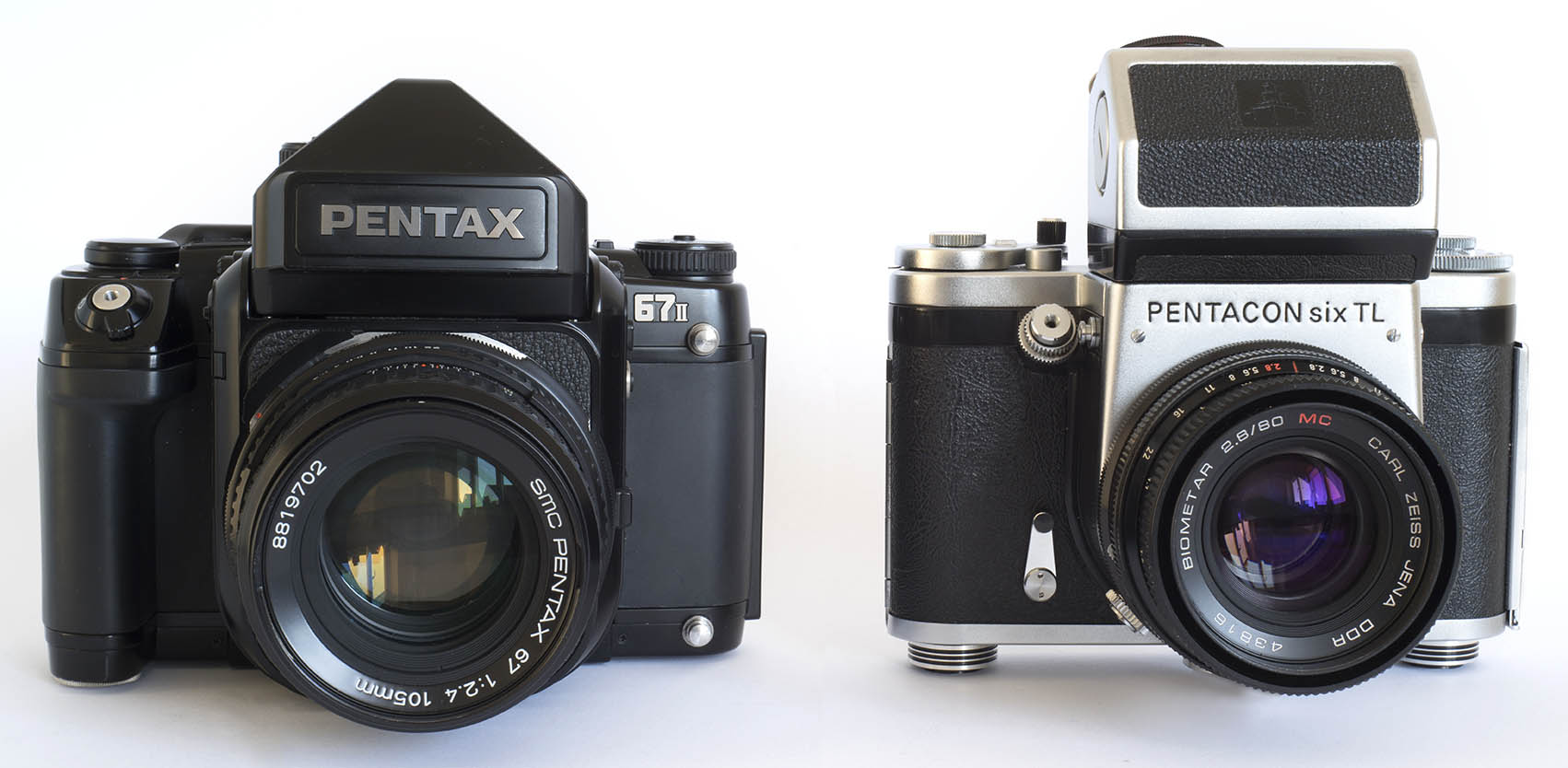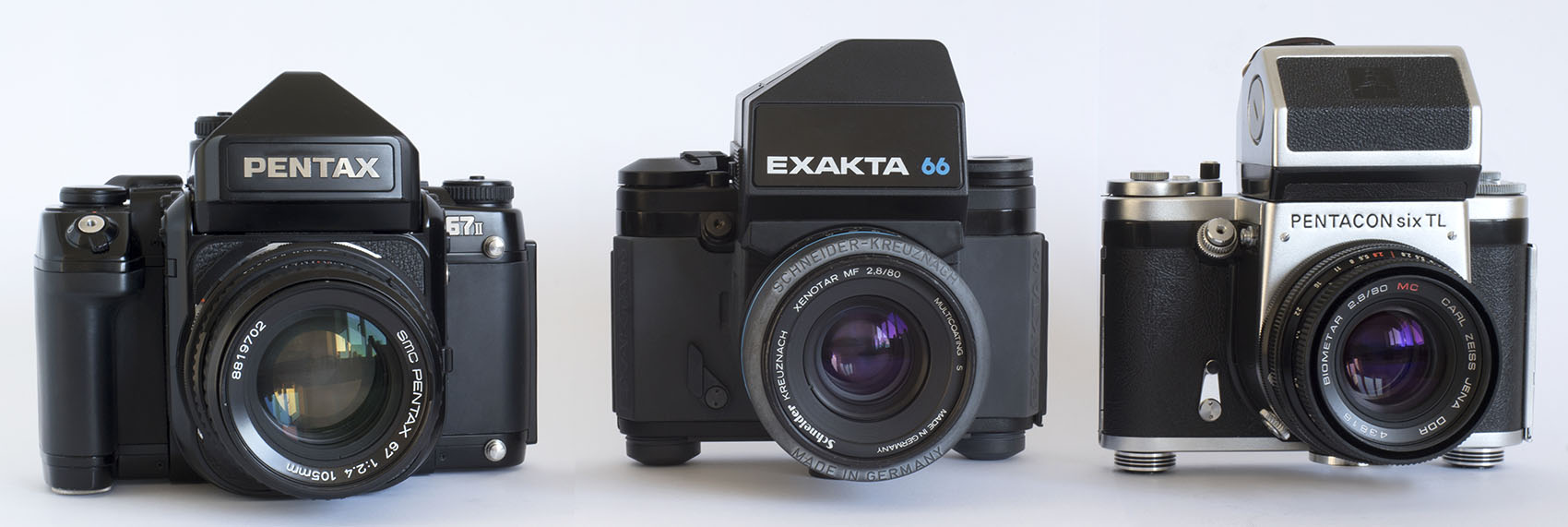|
The Pentacon Six System
by TRA
Pentacon Six or Pentax 6x7?
Having eliminated the Norita, I
considered the Pentax 6×7. Should I buy one
of these instead of a Pentacon Six?
A news item in the UK publication
“Amateur Photographer” in the late 1960s indicated
that the famous Japanese 35mm SLR manufacturer
Pentax was to make a medium format 6x6 camera
based on the Pentacon Six. This turned out
in fact to be the Pentax 6×7, which produced 10
exposures 55mm x 70mm on 120 film (or 20 on 220
film). It was hailed by the manufacturers as
the “ideal format” for magazine pictures, as they
claimed that most 6×6 images were cropped in order
to fill magazine pages. Their literature
stated that although the image size was only 21%
larger than a full 6×6, once the 6×6 image had
been cropped to a vertical format, the Pentax 6×7
original was in fact 50% bigger than it.
The bodies
The first impression
when one picks up a Pentax 6×7 is that it is big
and heavy – much bigger and much heavier
than the Pentacon Six.

The Pentax 6×7 with
the plain (non-metering) prism.
Picture reproduced from Pentax
publicity published in 1976 for the German
market
[Px67front.jpg]
|
|
To the left we see the
first version of the Pentax 6×7.
Note the slot in the shutter speed
dial (arrowed by me) in
which a pin from the metering prism
located, in order to transfer to the meter
the information on the shutter speed that
has been selected .
If only Pentacon had
thought to do this! Pentacon Six
lens mount users had to wait for the
Exakta 66 for the camera’s shutter speed
to be coupled with the TTL meter, and
when it came, Exakta chose a more
sophisticated electronic coupling.
The shutter
The Pentax
6×7 has an electronic shutter and is totally
battery dependent – if the battery
fails, the camera is dead – and battery
consumption is reported to be
high! The shutter is also very
noisy – not suitable for wildlife
shots. The shutter speed range is
the same as on the Pentacon Six: B, 1
sec – 1/1000 plus X. Flash sync is
1/30 second – the sync speed for which
the Pentacon Six was condemned by many
reviewers! However, the camera
with a basic, non-metering prism was
loved by some fashion photographers
aiming at dynamic shots with a hand-held
camera, and magazine editors loved the
format.
Like the Norita, and
unlike the Pentacon Six, it has an
instant-return mirror.
There is no delayed
action lever.
Bad
vibrations
The large mirror also
causes a lot of vibration (and
presumably a fair proportion of the
noise) at the end of its travel (just as
the shutter fires!). An “Amateur
Photographer” review years later (on
23rd January 1999) said that this “will
cause camera shake at speeds which you
would normally consider
handholdable”. Towards the end of
the 1970s a mirror lock up was added to
the camera. This enables vibration
to die down before releasing the shutter
– fine for macro, architectural and
still-life shots, but of no use for
hand-held shots or anything that moves.
A review of the final
version of the Pentax 67, published on luminous
landscape.com and written in
late 2001, states that further
vibrations are in fact caused by
the shutter itself, so even
using the mirror lock up will not solve
the problem:
| “what's
happened here is that the
shutter has bounced, as all
shutters do. So, there have
effectively been two
exposures. One during the
opening of the shutter and the
second during the closing, at
which point the camera had
essentially rung like a bell
thus causing the second
image.” |
|
The reviewer goes on to say that that
the Pentax 67 can be hand-held
| “only with
normal to short lenses, and only in very
good light or with fast film”. |
For most combinations of lenses and
films it is a tripod-only camera.
Worse, the reviewer goes on to state:
| “Pentax
states in their manual that the tripod
should weigh more than the camera. I'd
say the tripod and head should weigh at
least twice as much as the camera and
lens combination for ultimate rigidity.”
[emphasis mine] |
The reviewer concludes:
| “this is
best a tripod mounted camera, especially
with long lenses and slow shutter
speeds” |
If you plan to take your camera out
on hikes or on holiday, the implications of this are
worth considering.
|
The Pentax 67, Pentacon Six and Exakta 66
compared
The Pentax 6×7 went
through various revisions, soon losing the “×” and
becoming “Pentax 67”. The final version, released in
1998 and produced for a little over ten years, was
the “Pentax 67II”.

[Px67_&_P6_01.jpg]
|
|
Viewed side by
side, the Pentacon Six appears taller than the
Pentax 67II, a consequence of the spool holder
knobs under the base of the camera.
However, when the two cameras are taken in the
hand, the Pentax 67II is clearly bigger, wider
and much heavier than the Pentacon Six.
Here, both cameras are shown with their
standard lens, the 105mm f/2.4 Pentax lens and
the 80mm f/2.8 Carl Zeiss Jena Biometar
lens. The longer focal length and wider
maximum aperture of the Pentax lens
contributes to its weight, as well as the need
for it to cover a wider diagonal than lenses
for the Pentacon Six.
|

[Px67_E66_P6_01.jpg]
|
|
Pentax 67II,
Exakta 66 and Pentacon Six side by side, each
with their standard lens. The Exakta 66
had a choice of four different standard lenses
(see here) and
here we see it with its top standard lens, the
Schneider-Kreuznach 80mm f/2.8 Xenotar MF.
|

[Px67_E66_P6_02.jpg]
|
|
Top view, with
the metering prism on each camera.
|

[Px67_E66_P6_03.jpg]
|
|
The Focussing
Screens
Here we can see the focusing screen for each
of the cameras. The Pentax 67II screen
is of course wider than the screens in the
Exakta 66 and the Pentacon Six, but it is also
taller (viewed from this angle) than the
Pentacon Six/Exakta 66 screen. This is
because the Pentax 67II screen covers 100% of
the format, while the Pentacon Six/Exakta 66
screens do not.
However, with a prism mounted (both
the plain prism and the metering prism), one
can only see 90% linear of the screen on the
Pentax 67II (see below).
|

[Px67_E66_P6_04.jpg]
|
|
With the lens
removed, we see better the brightness of the
focussing screens. The Exakta 66 screen
is at least as bright as the Pentax 67
screen. The Pentacon Six shown here has
the same Rollei screen as the Exakta 66, but
here we are viewing it from a slight angle,
which makes it appear to be less bright.
|
The basic body does not have a
pentaprism, but in practice the camera is designed
for use with one – it is difficult verging on the
impossible to use the camera for vertical images
without one. Many models were sold with a
plain prism, although a fully-coupled TTL metering
prism was available. This is an improvement on
the Pentacon Six non-coupled prism.
Interestingly, the reviewer on
Luminous Landscape (see link, above) informs us that
| “The meter prism is
almost a must with this camera, but be
aware that it only shows 90% of the full
frame recorded on film.” [emphasis
mine] |
This is precisely the same as one of the criticisms
that has been made of the Pentacon Six prisms.
See details here,
at the bottom of the page.
Alternative Viewfinders for the
Pentax 6×7/67
A waist level finder and a magnifying head
were also available for the Pentax 6×7.
These might, in particular, be useful for
macro or studio work on a tripod (with
horizontal images only!), not for the
hand-held action shots for which the Pentax
6×7 was principally advertised.
The folding “waist level”
finder is on the left, here in its opened
position. It contains a 1.6x
magnifier.
The magnifying head is on
the right. It has a 1.3× magnifier,
and dioptric adjustment, clearly inspired by
the Pentacon Six magnifier head (see here).
The style of the lettering on
the viewfinders was changed over the years
to match the changing style of the camera,
but optically and mechanically there were, I
believe, no changes.
|
|

[Px67finders.jpg]
|
The lenses
With their wide experience of lens
design for their 35mm SLR cameras, Pentax were able
to produce an extremely impressive range of lenses
for the new format:
| Focal Length |
Aperture Range |
Angle of view
(1) |
Elements |
Closest Focus (m) |
Filter size (mm) |
Auto/Manual Aperture |
Weight (g) |
| 35mm |
f/4.5 – f/22 |
180° |
11 |
0.45 |
(2) |
Auto |
920 |
| 55mm |
f/3.5 – f/22 |
78° |
8 |
0.45 |
100 |
Auto |
920 |
| 75mm |
f/4.5 – f/22 |
61° |
5 |
0.7 |
82 |
Auto |
600 |
| 105mm |
f/2.4 – f/22 |
45° |
6 |
1.0 |
67 |
Auto |
628 |
| 135mm (3) |
f/4 – f/22 |
36° |
5 |
0.85 |
67 |
Auto |
767 |
| 150mm |
f/2.8 – f/22 |
33° |
5 |
1.5 |
67 |
Auto |
768 |
| 200mm |
f/4 – f/22 |
26° |
4 |
2.5 |
67 |
Auto |
900 |
| 300mm |
f/4 – f/45 |
17° |
5 |
5.0 |
82 |
Auto |
1,425 |
| 400mm |
f/4 – f/45 |
12° |
5 |
8.0 |
77 |
Manual |
2,570 |
| 600mm |
f/4 – f/45 |
8° |
6 |
12.0 |
77 |
Manual |
6,000 (4) |
| 800mm |
f/4 – f/45 |
6° |
6 |
20.0 |
77 |
Manual |
17,700 |
| 1000mm |
f/8 fixed |
5° |
6 |
35.0 |
(5) |
Manual |
6,400 |
(1) As the frame size and
image diagonal are larger than in the 6×6 format,
the angle of view is slightly wider, too. To
compare with the angle of view on 6×6 format lenses,
click here.
(2) UV, Y2, O2 and R2
built in
(3) Macro lens
(4) The Pentax 6×7 may
have been aimed at the dynamic user taking hand-held
action shots, but no-one will be hand-holding these
lenses! Even carrying them from the car might
be a problem! The 800mm lens makes Carl Zeiss
Jena's 1000mm Mirror lens seem light by
comparison. I suspect that some of these
lenses were only made to order, and no doubt had
prices in U.S. dollars close to the weight in grams!
(5) Y2, R2 and ND
built in
In addition – rather like with the
Norita – a lens with built-in leaf shutter was
offered. This enabled flash sync at speeds up
to 1/500 sec. Details are as follows:
| Focal Length |
Aperture Range |
Angle of view |
Elements |
Closest Focus (m) |
Filter size (mm) |
Auto/Manual Aperture |
Weight (g) |
| 90mm |
f/2.8 – f/22 |
53° |
6 |
0.85 |
67 |
Auto |
610 |
(By the 1990s, the 90mm leaf shutter
lens had been withdrawn, and replaced with a much
longer focal length 165mm f/4 leaf shutter lens.)
All of the lenses have Pentax’s SMC
multi-coating.
Other lenses have been added over the
years.
Inspired no doubt by the 1930s 35mm
Contax rangefinder cameras (which had in turn been
copied by Nikon in the 1950s), the Pentax 6×7 had
two lens mounts: a smaller one for the shorter
lenses, and outside it a larger mount for the much
heavier lenses (400mm and longer).
The
accessories
An extremely wide range of
accessories were produced for the Pentax 6×7.
In 1976 the following items were listed:
- A 2× converter for lenses from
400mm and longer
- A magnifying eyepiece for the
pentaprism
- Two sets of extension tubes – one
for each of the bayonet mounts
- A focussing tube
- A 67mm reversing ring
- Bellows
- Slide copier bellows
- An angle finder for the prism
- An adapter to use 6×7 lenses on
Pentax 35mm SLRs
- A camera grip and a lens fast
focussing grip (inspired, no doubt, by Hasselblad)
This was extremely impressive. In
addition, there were of course lens caps, filters,
etc. Other 2× converters were subsequently added for
lenses up to 300mm, which use the camera’s inner lens
bayonet mount.
My decision
The Pentax 6×7 system was
impressive. Yet I took the decision not to buy
into it. My reasons were:
- Its bulky size and weight
- Its total dependence on
batteries.
- Its noisy shutter.
- The vibrations caused by the
mirror and the shutter
- The extremely high cost of the
camera, lenses and accessories.
The system continued to be developed
over the decades, with both cosmetic changes and a
more up-to-date metering prism. But I have not
regretted my decision since taking it – I could never
realistically have afforded the system, nor have
justified spending so much money, even if it had been
at my disposal. The Pentax 6×7 was and is
clearly targeted at the successful professional with a
large budget (which is also why many used Pentax 6×7s
that are sold have had a very heavy life – be
warned!).
Is it possible to modify
Pentacon Six lenses so that they can be used on the
Pentax 6×7? For a consideration of this, click
here.
For the introduction to using Pentax
6×7 / Pentax 67 lenses on the Pentacon Six, see here.
For the results of tests of Pentax
6×7 / Pentax 67 lenses on the Pentacon Six and on
the Pentax 67II, see here
and here.
To go back to the introduction to the
cameras, click here.
To return to the section on the
pentaprisms, click here.
To return to the interview with the
author, click here.
Home
© TRA November 2005 Latest revision:
June 2021
|






